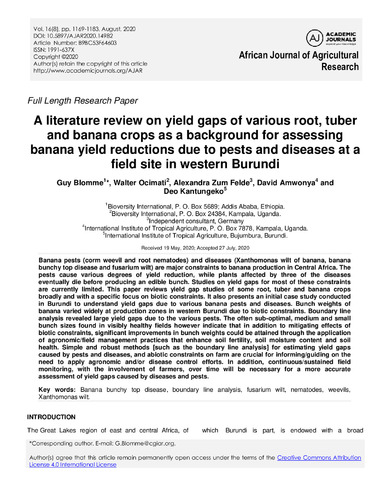A literature review on yield gaps of various root, tuber and banana crops as a background for assessing banana yield reductions due to pests and diseases at a field site in western Burundi
Banana pests (corm weevil and root nematodes) and diseases (Xanthomonas wilt of banana, banana bunchy top disease and fusarium wilt) are major constraints to banana production in Central Africa. The pests cause various degrees of yield reduction, while plants affected by three of the diseases eventually die before producing an edible bunch. Studies on yield gaps for most of these constraints are currently limited. This paper reviews yield gap studies of some root, tuber and banana crops broadly and with a specific focus on biotic constraints. It also presents an initial case study conducted in Burundi to understand yield gaps due to various banana pests and diseases. Bunch weights of banana varied widely at production zones in western Burundi due to biotic constraints. Boundary line analysis revealed large yield gaps due to the various pests. The often sub-optimal, medium and small bunch sizes found in visibly healthy fields however indicate that in addition to mitigating effects of biotic constraints, significant improvements in bunch weights could be attained through the application of agronomic/field management practices that enhance soil fertility, soil moisture content and soil health. Simple and robust methods (such as the boundary line analysis) for estimating yield gaps caused by pests and diseases, and abiotic constraints on farm are crucial for informing/guiding on the need to apply agronomic and/or disease control efforts. In addition, continuous/sustained field monitoring, with the involvement of farmers, over time will be necessary for a more accurate assessment of yield gaps caused by diseases and pests.

